Recap: working session CoP14
On the 18th of November the members of the Coalition of the Willing Promote Pollinators and some interested others joined in a meeting to exchange experiences and discuss the organization.
Updates by (aspiring) members of the coalition Promote Pollinators
Dominican Republic – professor José Almonte
Professor José Almonte presented the interim results of the BES-Net trialogue laying down and scaling the impact of global assessments of biodiversity and ecosystems. These second regional trialogues of the Caribbean on pollinators, food safety and climate resilience are multi-sectoral conversations to generate changes in public policy and practice at a regional and national level, in response to the results of global assessments of IPBES. They are trialogues between science, government and civil society on complex information:
- To bridge the gap between the sectors of science, policy and practice.
- To create a shared space to analyze the results of the evaluation of IPBES altogether and share regional, national, and local knowledge.
- To identify options for public policy altogether, generate commitments and build a common action agenda.
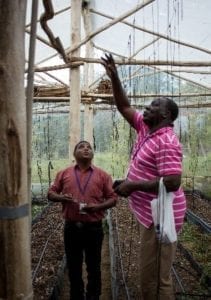
The priority is achieving results and co-creating a common action schedule by preparing, and facilitating an Agenda for Action with regional and national commitments in the short and medium term. It is a good collaboration between countries that really makes the difference. A kind of regional Coalition of the Willing!
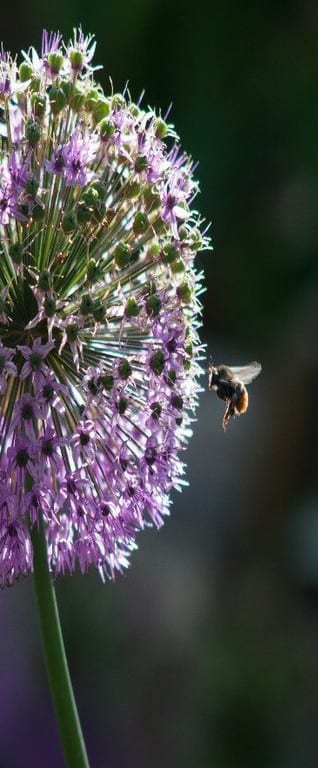
European Commission – Laure Ledoux
Laure Ledoux updated the participants about how the EU realised the EU Pollinators Initiative. We all know that pollinators are declining at an alarming rate and that this will have far-reaching consequences for the functioning of ecosystems and our wellbeing. The European Commission recognized the clear threat of the pollinator decline and the need to step up action to tackle it. This is the driving force behind the EU Pollinators Initiative, the first single, coordinated EU action to tackle the decline of pollinators. The initiative has been delivered in a short time. In the preparation of the initiative, the Commission consulted citizens and stakeholders across various sectors. Right from the start, the preparation of the initiative attracted high attention. The initiative sets the framework for an integrated approach to the problem through improving knowledge and collaboration, and a more effective use of existing tools and policies. The initiative focuses on wild pollinators; however, its actions will also greatly benefit domesticated pollinators like honeybees. They expect the beekeeping sector to actively contribute to the implementation.
Priorities:
- Improving knowledge
- Tackling causes of decline
- Awareness, engagement and collaboration
Successful addressing of pollinator declines requires a long-term strategic approach. The initiative sets long-term objectives towards 2030. Short-term actions, that will put key processes in motion, will be implemented by 2020. Then, the Commission will review progress on the implementation and, if necessary, propose recommendations for further action.
Presentation on FAP in Northern Africa – Dr. Stefanie Christmann, CGIAR
Stefanie Christmann presented the results about the economic impacts of farming with alternative pollinators (FAP) in Morocco and the first results of the IKI project on pollinator protection (2017-2022). Current approaches to protect wild pollinators are not scalable as Low and Middle Income Countries cannot afford them. That is why this project has introduced rewards for wildflower strips and sponsored events to provide information and convince stakeholders. How can you make a shift from pollinator-friendly agriculture to farmer-friendly pollinator protection? In Morocco, ICARDA experimented with FAP Fields: Main crop in 75% of the field and habitat enhancement in 25% of the field. In the project, the impact of habitat enhancement on insect diversity and abundance (pollinators, native enemies, pests) is assessed, as well as on the total net income per surface. Results: Higher pollinator and predator diversity and abundance, and an increase of net income per unit of surface.
- Low investment for farmers
- High pay-off already in the first year
- Easy to communicate by ICT
Full FAP projects like this IKI project have 4 steps:
- Demonstrate the higher income to trigger intrinsic motivation of farmers
- Planting pollinator corridors between enhanced agricultural and natural sites
- Stimulate cooperation of political stakeholders across sectors
- Mainstreaming pollinator protection by national governments across sectorsPollinator protection should be feasible in all countries, let’s do it!
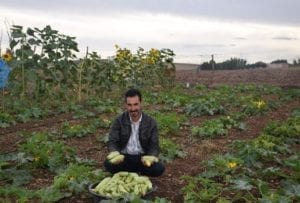
Science and data to underpin a pollinator strategy – Professor Koos Biesmeijer
How do you come from many initiatives to one strategy? How can information, knowledge tools and big data help? And what can we learn from each other? Professor Koos Biesmeijer told us more about the strategy of the Netherlands and the role of information, knowledge, tools and big data. He explained how the Ministry of Agriculture, Nature and Food Quality in the Netherlands gathered about 100 initiatives from across society and linked them with their own goals to produce a strategy with an ambition and clear goals for 2023 and 2030.
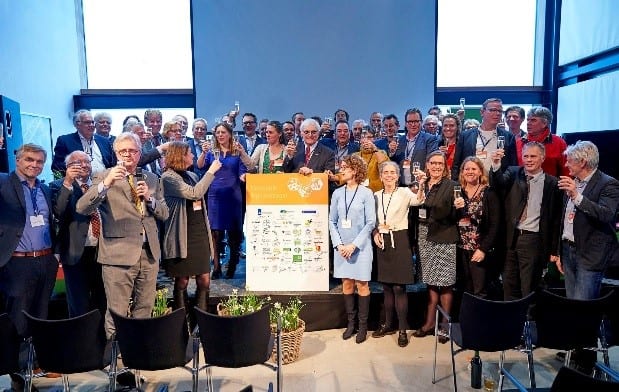
Analysis of NL initiatives:
- Much enthusiasm and activity, but:
- Often no clear link to NL strategy
- Some very different goals (e.g. awareness)
- Therefore, no guarantee to reach the national goals
In order to bridge the gap between the projects and the strategic goals, information, knowledge data, tools and big data are needed. How can progress be measured? If there are no direct data, can we find proxies to measure progress towards the goals? An opportunity can be found in Big Data for Bees. This is a project that will seek to
- Formulate clearer goals for the initiatives that are linked to NL strategy
- Develop a toolbox for initiatives and governments
- Better monitor of progress towards goals
What can we learn from each other?
- Dance like the honeybees Information sharing and communication
- Swarm like the honeybees Collaboration in a coalition
- Be successful like the honeybees Move in similar direction for the future
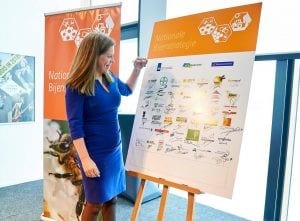
Discussion on organizational model of the coalition
Why is an organizational model needed?
- To continue work in the following years,
- To support sharing knowledge and learning from each other,
- And to provide managerial and financial support.
The choice of model should be in line with the desired character of the coalition:
- Lively, learning network
- Informal governance
- ‘Lean & mean’ > efficient
But offset drawbacks & risks!
Proposal:
- Network organization
- Certain conditions to manage drawbacks & risks attached to a network organisation:
- Leadership through revolving chair
- Support through secretariat (events, newsletter, website, liaison)
- Form of governance & rule book, operating mode
- Evaluation
A discussion document outlining this proposal has been sent to the members and will be resent, to be discussed at the next CoW event (possibly during the IPBES meeting in Paris).
Finally, participants were asked to write down answers on two questions. At the meeting participants were asked to note down their main challenges and questions regarding knowledge and information. This is the harvest:
Which knowledge & information do you require to take your next step?
- More info on pollinators and how to increase and conserve them. Kids, elderly, politicians, NGOs, GOs, farmers …
- Data on pollinators, staff working on the issue, connecting grasslands conservation with pollinators
- Durante el Trialogo Regional del Caribe se identifico un gran vacio de informacion sobre cuales polinizadores tenemos y qu.. condiciones de conservacion estan (?) las especias y los ec… donde habitar (?) (During the Regional Trialogue of the Caribbean we have identified a large knowledge gap on which pollinators we have and which conditions of conservation the species require, and which habitats (?) )
- Realizar estudios de linea bases e identificar los vacios de informacion (Realise baseline studies and identify the knowledge gaps)
- Mas investigacion sobre la biologia de las especias (More research on species biology)
- Need for taxonomic expertise to undertake quality monitoring
- Continue to share approaches, ideas, data/research (e.g. IPBES).
- Better exchange/access of data between environmental and agricultural sectors (better data-sharing)
- Learning network means exchange of lessons learned, best practice a.o.
- Contribution (of pollinators to) food quality
- Pollinators and pollination in smallholders farms and farmers are not recognized.
- Sharing knowledge between Agricultural and Environmental sectors.
- [How to address] agriculture + non-point pollution control, + biodiversity? [How to address] dry land agriculture tech, modern (industrial) agriculture and pollinator concerns? How to start, which ministry should lead?
- Can pro-pollinator and use of GMOs co-exist in the same landscape?
- Adverse effects of neonicotinoids and possible substitutes (we need this information for decision-making)
- Continued / further research e.g. pesticides, interaction between wild and managed pollinators.
- Mapping conflicting interests between domesticated and wild pollinators. Develop guidance for handling conflicting interests.
- We lack experts on wild pollinators
- Shortage of experts working on wild pollinators
- What is the best approach to link pollinators with the species they pollinate?
- Our national action plan for the conservation of pollinators, address lack of knowledge on wild species. After the implementation on some actions of the plan, we should be able to propose another set of actions to improve the management of wild species.
- How do we all secure that the Pollinators’ Initiative is integrated into other sections, e.g. infrastructure
- Challenge: how to develop and fund – in the long-term – large-scale (e.g. EU-wide) monitoring scheme, to support the development of new indicators.
- Readiness of the coalition to support a Multilateral Environmental Agreement for pollinator protection
- Cumulative effects of stress factors, pollutants, insecticides, pesticides, invasive species, pathogens, habitat loss, on wild and domestic pollinators
- Best methods to establish a bee hotel are required
- Based on the CGIAR presentation on FAP: can COW play a role in supporting countries through funding or capacity building and expert support
Which successes would you like to share?
- National Pollinator Strategy and more of public awareness and knowledge like NL
- Uso de toncos de arboles muertos en las zonas de cultivo, como alvergue de polinizadores (Use of trunks of dead trees in cultivation areas, as a pollinator shelter)
- Spain is elaborating the National Action Plan for the Conservation of pollinators. We expect that the plan will be approved during 2019
- Guiana shield initiative | Project guianashield.org / guianashieldfacility@gmail.com
- Uso de plautas meliferas en las zonas de cultivo para atraer a los pollinazadores (Use of melliferous plants in cultivation areas to attract pollinators)
- Science: contribution to IPBES; Pollinator status indicator; UK-wide Pollinator monitoring and research partnerships (academics and NGOs)
- Dutch regional authorities really involved in achieving targets on pollinators
- Increased work, cooperation, awareness-raising (generally) on pollination and role of pollinators
- IPBES and increasing the focus on other bees their use and conservation – as stingless bees, for instance
- Joining the CoW as founding partner; working on establishing monitoring of pollinators with experts
- National strategy of pollinators of Finland will be ready by 2019
- Income increases from FAP, policies from FAP, within time: stewardship for pollinator-protecting agriculture
- Big participation in the online dialogue platform on the new Action Programma insect protection
- Forthcoming key actions: Long-term: EU-wide monitoring scheme for new indicator. Short-term: Virtual exhibition on pollinators (awareness-raising)
- In Denmark: several local projects, e.g. shelter belts with at least 50% pollinator-friendly species. 13.800 ha untouched woods (2018). Pollinator strategy (2016), education and research, etc. Pesticide taxes (reduce use, since 2013)
- A new project “Projecting farmland pollinators” has been approved; €1,2 million funding (co-funded by EU EAFRD)
- Experiencia exitosa del uso de Polinizador nativo para la produccion de tomates en ambiente controlado. (Successful experience of the use of native pollinators for the production of tomatoes in a controlled environment)
- El uso de abejas para aumetar la produccion de aguicate por parte de agricultura. (The use of bees to increase the production of avocado through agriculture
- Increased the number of native plant species and fruit-bearing species in restoration activities
- Increased the amount of privately owned lands which have been enriched and/or restored with fruit-bearing species
- Siguiente año, tenemos programado un taller de polinizadores en Mexico (Next year, we have a workshop on pollinators scheduled in Mexico
- World Bee Day initiative – 20th of May – to promote safety of bees and their importance
- It is not a Ministry for the Environment project but Uruguay is about to approve a National Plan on Ecological Agriculture that is going to include pollinators conservation actions on site … especially in food production
- ECOBEE, LTSER Plaine-Val de Sèvre (10 years) Multidisciplinary project: 1) ecology, agriculture 2) Agro and non-agro 3) With farmers, policy-makers, NGOs
